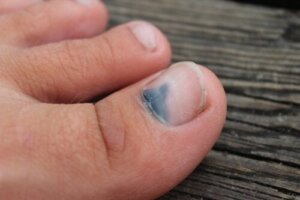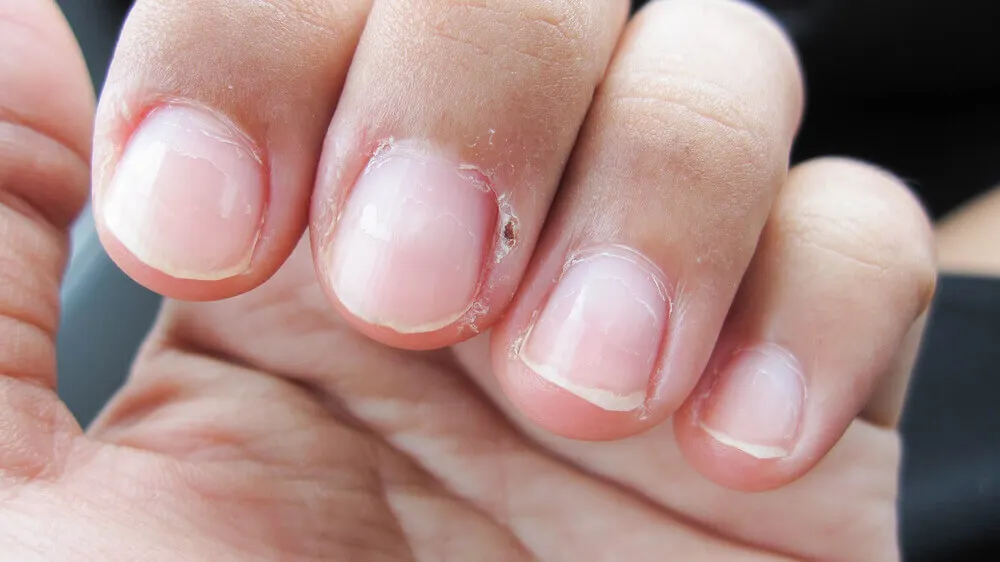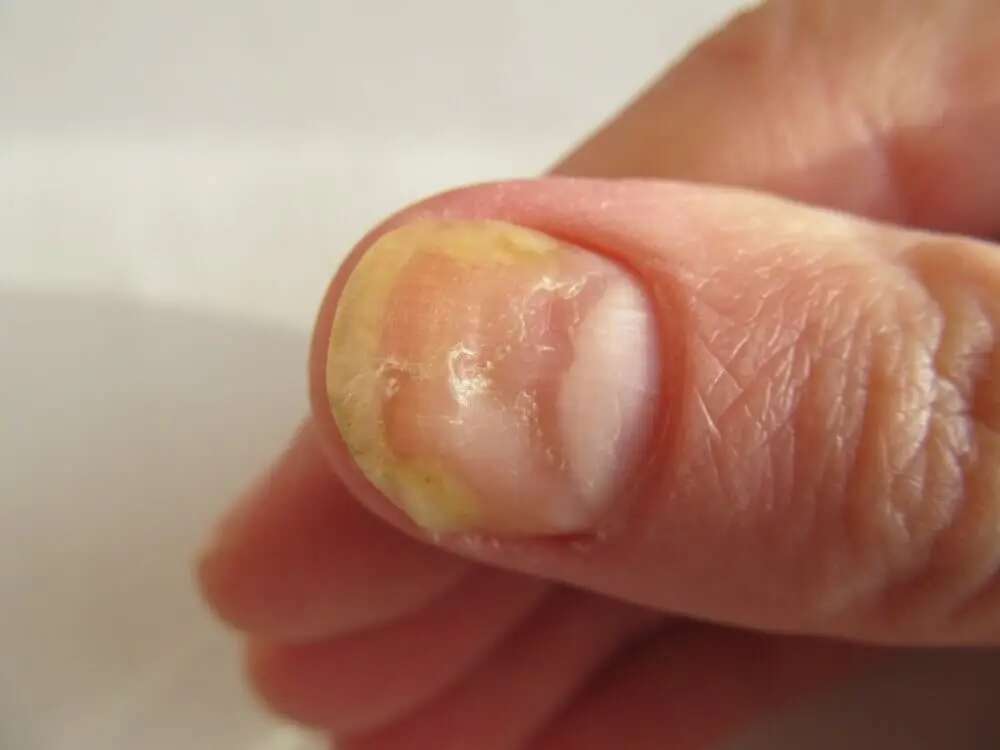Causes and Treatment of Onycholysis


Written and verified by the doctor Leonardo Biolatto
HERE
Onycholysis comes from the Greek onychus meaning ‘nail’ and lysis meaning ‘destruction’. It is a condition in which one or more nails become detached from the skin underneath them. It can occur on both hands and feet. It is not considered serious.
However, it is true that it can be the symptom of a potentially more severe disease. Therefore, in this article we explain why it can occur and how it is treated.
What is onycholysis?
Onycholysis is when the nail plate separates from the nail bed. The nail is made up of hardened dead cells containing keratin. The nail bed, on the other hand, is the connective tissue underneath, connecting to the toe.
It is a fairly common disorder. The reason is that it can have multiple causes, from trauma or infection to systemic diseases.
When this condition occurs and the nail begins to separate, its color varies. The color changes depending on the cause of the condition. For example, it can be dull white, gray, green or yellow.
The problem is that this condition takes months to recover from. Specifically, it usually takes 4 to 6 months before the nail is complete again. In the case of the feet, the time may be longer until the nail is fully developed.
As a Dermnet NZ publication explains, the surface of the nail can also vary with onycholysis. It may be brittle, notched or have small dimples. In addition, there is usually a distinct, irregular border between the healthy area and the raised portion.
In many cases it is painless. When pain appears, it may be a symptom of an inflammatory or acute lesion. Similarly, this lifting can occur chronically or acutely.

What can cause onycholysis?
Onycholysis is a very common condition. The reason is that one of its causes is trauma. Both a strong blow and repeated trauma can cause the nail to separate from the skin. For example, when someone presses their finger against a door.
Infections are another common cause. Especially fungal infections, which are typical on the feet. In fact, candidiasis is one of the health problems most commonly associated with this problem. Bacterial infections, such as those caused by pseudomonas, are also common.
Some people suffer from onycholysis due to a reaction to certain chemical products. It often occurs when using certain nail polishes or very aggressive nail polish removers. It can even occur due to an allergic reaction to them or to other medication.
Among the serious diseases that can cause the nail to become detached is psoriasis. Psoriasis is a chronic inflammatory skin disease. Onycholysis is one of the signs associated with a more aggressive presentation.
Certain nutritional deficiencies, such as vitamin or mineral deficiencies, can also lead to this problem. According to a Sochiderm publication, other diseases such as systemic lupus erythematosus, iron deficiency anemia and diabetes cause it.
Other causes include the following:
- Thyroid problems.
- Skin pathologies, such as lichen planus, alopecia areata and hyperhidrosis.
- Drugs used in chemotherapy, antihypertensives and retinoids.
- Continuous exposure to moisture and irritants.
When should you seek help from a doctor?
Many people tend to give little importance to this problem or to dismiss its relationship with other pathologies. However, onycholysis can be a sign of a serious condition. It is therefore always advisable to consult a doctor.
Although it is not the main cause, it predisposes to nail infections. Both fungal and bacterial can spread and cause damage to the rest of the limbs if left untreated.
You may be interested in: How to stop mycosis on feet: 6 home remedies
Treatments available for onycholysis
The treatment of onycholysis is going to depend on the cause. That is why it is essential to make a proper differential diagnosis.
In addition, we must try to ensure that, once the nail has detached, infections do not appear. The area must be clean and disinfected. It is not recommended to instill water under the nail.
When the cause of onycholysis is a fungal infection, antifungal drugs are recommended. They are administered in the form of creams or ointments on the nail or finger.
Systemic diseases, such as thyroid problems, should be treated by a specialist. The idea is to stabilize the hormones. If there is a vitamin or mineral deficiency, the approach is usually based on modifying the diet or including supplements.
Home remedies and care
There are certain home remedies and care that can be beneficial for onycholysis. For example, the use of essential oils, such as tea tree oil, improves fungal infections.
The reason is that tea tree oil has natural antifungal properties. However, it should not replace any medical prescription.

You might be interested in: Useful tips for onychomycosis
Prevention and recommendations
Onycholysis can sometimes be prevented. Especially those cases that are associated with constant exposure to irritants or moisture. It is important to use gloves or appropriate footwear.
Also if you are going to do sports. It is not advisable to wear closed and not very breathable footwear for too many hours. In addition, it is essential to maintain a complete and balanced diet. This avoids nutritional deficiencies of iron, for example. Moreover, try to keep the nails clean and well cared for, as well as avoiding frequent trauma to the area.
Anyone with thyroid disease or psoriasis should follow the treatment instructions established by a physician. If it still does not improve, it is important to return for further consultation.
Onycholysis is not serious, but should not be neglected
Onycholysis is a common condition in which the nails become detached from the underlying skin. It can occur due to multiple causes, such as trauma or irritants.
Although it is often benign and self-limiting, it is also a symptom of other pathologies. For example, psoriasis or nutritional deficiencies.
It is therefore essential to monitor this condition and diagnose the cause . In addition, treatments are usually recommended to prevent infection of the area that complicates the evolution.
All cited sources were thoroughly reviewed by our team to ensure their quality, reliability, currency, and validity. The bibliography of this article was considered reliable and of academic or scientific accuracy.
- Sandoval, M., & De Grazia, R. (2014). CASOS CLÍNICOS Onicolisis de las 10 uñas de las manos. Rev. Chilena Dermatol (Vol. 30).
- Onycholysis | DermNet NZ. (n.d.). Retrieved May 19, 2021, from https://dermnetnz.org/topics/onycholysis/
- Sánchez-Regaña, M., and P. Umbert. “Aspectos diagnósticos y terapéuticos de la psoriasis ungueal.” Actas Dermo-Sifiliográficas 99.1 (2008): 34-43.
- Lucas San Atanasio, Delia de. “Manifestaciones cutáneas de las enfermedades de tiroides: Revisión.” (2017).
This text is provided for informational purposes only and does not replace consultation with a professional. If in doubt, consult your specialist.








